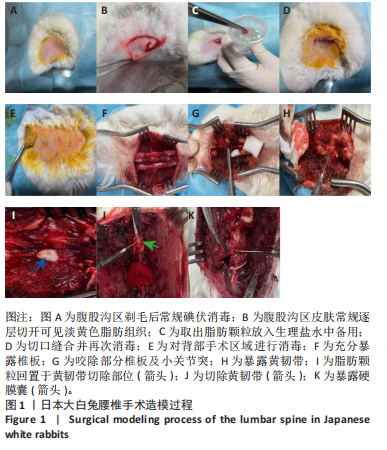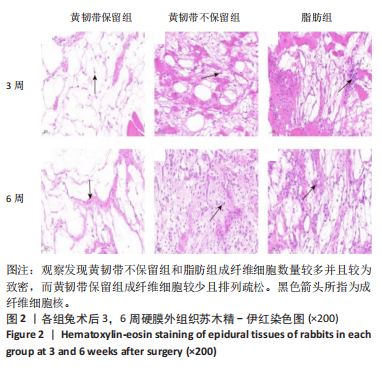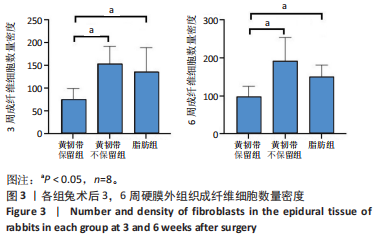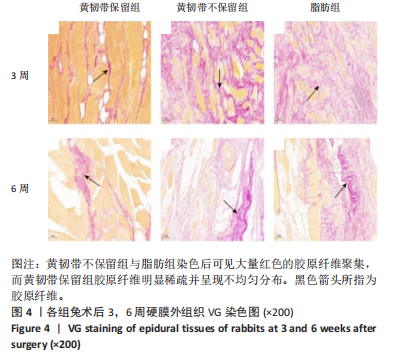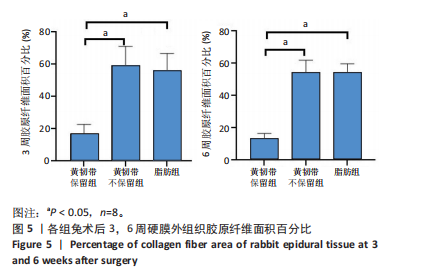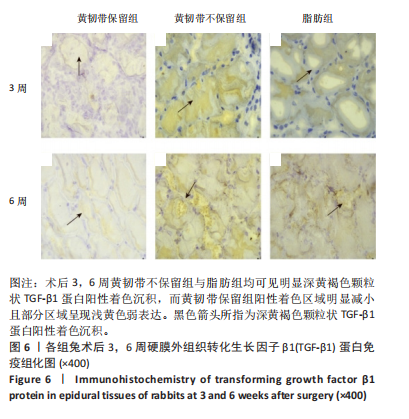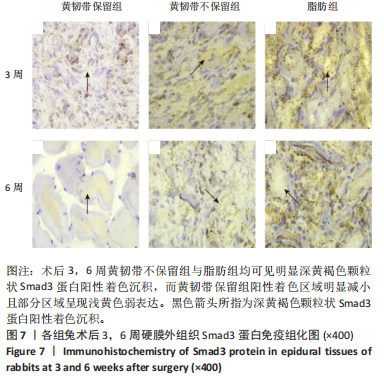中国组织工程研究 ›› 2025, Vol. 29 ›› Issue (6): 1168-1175.doi: 10.12307/2025.325
• 肌肉肌腱韧带组织构建 tissue construction of the muscle, tendon and ligament • 上一篇 下一篇
自体黄韧带干预下兔硬膜外纤维瘢痕的形成
张德宝1,王 鹏1,李 琨2,张少杰2,李志军2,李树文1,吴一民1
- 1内蒙古医科大学第二附属医院脊柱外科中心,内蒙古自治区呼和浩特市 010000;2内蒙古医科大学解剖学教研室,内蒙古自治区呼和浩特市 010000
Epidural fibrous scar formation in rabbits following autologous ligamentum flavum intervention
Zhang Debao1, Wang Peng1, Li Kun2, Zhang Shaojie2, Li Zhijun2, Li Shuwen1, Wu Yimin1
- 1Center for Spine Surgery, Second Affiliated Hospital, Inner Mongolia Medical University, Hohhot 010000, Inner Mongolia Autonomous Region, China; 2Anatomy Teaching and Research Department, Inner Mongolia Medical University, Hohhot 010000, Inner Mongolia Autonomous Region, China
摘要:
文题释义:
黄韧带:参与构成椎管后壁,连接相邻的上下位椎弓板,起于C2,止于S1,分节存在,由大量弹性纤维构成,使其在受到拉伸时可延展变长变薄;在椎板互相靠近时,又可短缩,不至形成褶皱而突入椎管。
纤维瘢痕:指受到创伤等情况后,组织改建形成细胞分裂或是增生,使受损部位迁移,产生细胞外基质,形成纤维瘢痕。
背景:临床已证实,腰椎术后纤维瘢痕与硬膜或神经根粘连是造成术后疼痛及麻木等症状的重要因素。
目的:验证自体黄韧带抑制腰椎术后硬膜外纤维瘢痕形成及探究可能的分子生物学机制。
方法:选择6-8月龄的日本大白兔48只,利用随机数字表将兔分为3组:黄韧带保留组、黄韧带不保留组、自体脂肪回置组(脂肪组)。3组兔均建立腰椎椎板切除术模型,于造模后3,6周收集兔硬膜外组织,采用苏木精-伊红染色观察组织变化及成纤维细胞数量密度,VG染色观察胶原纤维面积百分比,免疫组化观察转化生长因子β1、Smad3蛋白的表达。
结果与结论:①苏木精-伊红染色结果:黄韧带保留组成纤维细胞较少且排列疏松,黄韧带不保留组和脂肪组成纤维细胞数量较多且排列紧密,术后3,6周黄韧带保留组成纤维细胞数量密度小于黄韧带不保留组和脂肪组(P < 0.05),而黄韧带不保留组和脂肪组之间比较并未有明显差异;②VG染色结果:黄韧带保留组胶原纤维稀疏且分布不均,而黄韧带不保留组与脂肪组可见大量红色胶原纤维聚集;术后3,6周黄韧带保留组胶原纤维面积百分比小于黄韧带不保留组和脂肪组(P < 0.05),而黄韧带不保留组与脂肪组之间无明显差异;③免疫组化结果:黄韧带保留组蛋白阳性着色程度明显弱于其余两组;术后3,6周黄韧带保留组转化生长因子β1、Smad3吸光度值显著低于其余两组 (P < 0.05),而黄韧带不保留组和脂肪组之间无显著差异;④结果说明,腰椎手术后均会存在不同程度的硬膜外纤维瘢痕的形成。若在术中保留自体黄韧带,可有利于减少硬膜外成纤维细胞数量以及胶原纤维的形成,从而减轻纤维瘢痕组织与硬膜囊、神经根的粘连,其机制不仅为单纯的机械阻隔作用,同时也可通过干预转化生长因子β1/Smad3信号通路来减少硬膜外纤维瘢痕的形成。
https://orcid.org/0009-0006-7418-1299(张德宝);https://orcid.org/0000-0002-4610-832X(王鹏)
中国组织工程研究杂志出版内容重点:组织构建;骨细胞;软骨细胞;细胞培养;成纤维细胞;血管内皮细胞;骨质疏松;组织工程
中图分类号:
